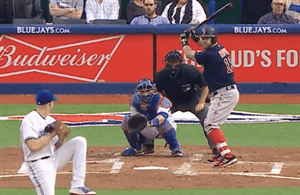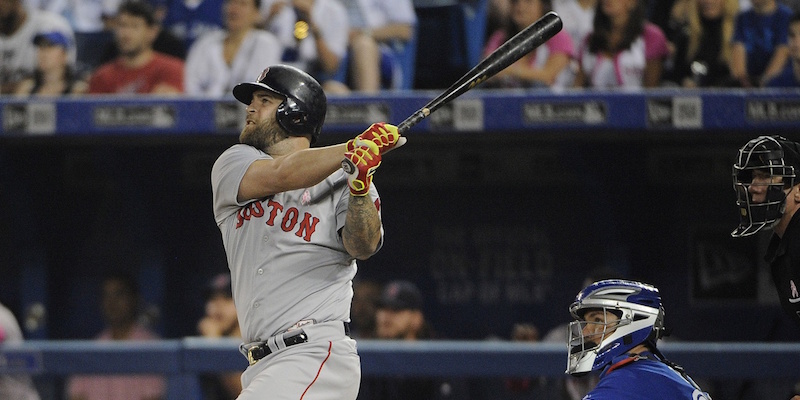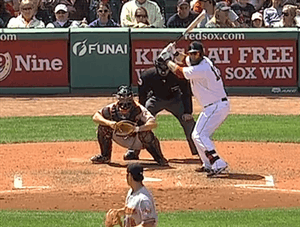Thanks to a robust walk rate and helpful power, Mike Napoli finished last season with a True Average of .294 for the the second straight year, ranking just behind David Ortiz for second on the team among players with at least 400 plate appearances. With 110 PA in 27 games for the team this year, Napoli’s True Average has dropped to .216 so far . Is that cause for concern?
Rarely one for high batting averages, Napoli’s .146 BA through Saturday is what sticks out the most. His atrocious .194 BABIP is the driver there, although a strikeout rate over 20% certainly doesn’t help. The bad news: Napoli has probably earned that BABIP. Most hitters see a line drive rate hover around 20%-22%, and line drives become hits around 70% of the time: almost four times as often as all other kinds of batted balls. With a line-drive double on Saturday, Napoli increased his line drive percentage — to just 12.16%, according to batted ball stats at Baseball Prospectus. Napoli has still been a little unlucky, just based on his batted ball distribution, but most of that low BABIP appears to be earned.
Still, there are definitely reasons to think that Napoli’s performance at the plate for the rest of the season will match his .294 TAv projection more closely than his performance to date. An 11.8% walk percentage lags a bit behind his 15.6% rate from last year, but it’s still well within range of his 12.5% career walk rate and 2013’s 12.6%. And in one way, the power is still there even though the hits haven’t been; six extra-base hits are fewer than we would have expected, but it still means that less than two-thirds of his hits have been singles: a clip almost identical to last year.
There are even more positive signs. Napoli has improved his approach at the plate in some ways that we should care about. A low swing percentage on pitches outside the zone has been a Napoli calling card, but that rate, now 19%, is even better than the 22% he’s had over his career. He’s swung at pitches in the zone more frequently, up to 63%, and his contact rate in the zone is also better, up about three percentage points to 82%. Based on these peripherals, we’d expect Napoli to do better, not worse.
Very good plate discipline rates don’t necessarily mean that the physical bat-to-ball skill that turns into line drive rate won’t start to slip with time.
It’s really just the line drive percentage that gives cause for concern. It’s the type of thing we see when Sluggers Go Bad, as it did for Dan Uggla before he washed out with the Braves last year. As with Uggla, very good plate discipline rates don’t necessarily mean that the physical bat-to-ball skill that turns into line drive rate won’t start to slip with time. And part of accuracy with the bat is timing. A little too slow a little more frequently, and hitters with an uppercut like Napoli hit the ball into the air more frequently. Get too ahead too often, and the bat won’t just be in front of the ball — it’ll be on top of it.
It could just be that I lack the expertise, but I don’t see Napoli struggling to keep up more often, or mis-timing his swing. But for what it’s worth, he’s a foul tip high from April 21, 2014:
And one from last Friday:

It’s hard to watch games and not notice Napoli’s lack of success; even over just a month, a hundred points of batting average is hard to miss. But the only alarming bit of Napoli’s peripherals is that drop in line drive rate and, dramatic as it may be, with 74 batted balls in play through Saturday, a difference in line drive rate of 8 to 10 percentage points is only a difference of 3-5 batted balls. That’s not a reason for panic, especially since he did manage a 21.75% line drive rate in 2014. That’s down from a 23.40% rate in 2013, but not so far down that we’d start to conclude his skills were eroding. If he’s still in the mid teens by the end of the year, it’d be hard to see the team bringing him back for 2016, but we’re still pretty far away from that.
Fortunately, there’s good news. Thanks to MLBAM, Statcast and Baseball Savant, we have more information to work with: batted ball velocity. Whereas line drive rate is mostly a function of trajectory — of being accurate with the bat vertically, possibly through timing — it doesn’t do a whole lot to help us with changes in bat speed or the accuracy of swings horizontally. It’s hard to fake batted ball velocity. Our history with this new data point is still very brief, but I think we can go as far as saying: very low average batted ball velocity probably means poor horizontal accuracy and poor bat speed; very high average velocity probably means good accuracy and good bat speed; and we may still be at a loss for players who hang out in the middle.
We’re not at a loss with Napoli. Velocity has been tracked for 51 of Napoli’s batted balls, and among hitters with at least 20 tracked, Napoli fits comfortably in the top 10% with an average batted ball velocity of 92.94 mph. All players with at least 20 tracked balls have hit at least one over 100 mph; at this point, it seems like the average says a lot more. Just three of those 51 tracked batted balls were slower than 75 mph, which is, I believe, a good sign that he’s not missing horizontally with the barrel of the bat. What’s more, the most recent of those three was on April 20.
Here are how frequently tracked batted balls have turned into hits, in some velocity buckets I chose arbitrarily:
| Speed | 31-74 mph | 75-89 mph | 90-99 mph | 100+ mph |
| Tracked Balls | 2416 | 4780 | 4995 | 3594 |
| Hits | 529 | 1048 | 1626 | 2147 |
| Batting Avg | .219 | .219 | .326 | .597 |
| Slugging Pct | .245 | .258 | .483 | 1.180 |
| Errors (%) | 47 (1.9%) | 59 (1.2%) | 68 (1.4%) | 45 (1.3%) |
Note that these batting averages aren’t really “batting average”; it’s the percentage of tracked balls that were hits, and I did not remove errors, sac flies etc. as one would for a real batting average. Still, there is a very strong relationship between batted ball velocity and success, especially for “slugging” — and that makes Napoli look better than some of his other numbers.
| Speed | 31-74 mph | 75-89 mph | 90-99 mph | 100+ mph |
| MLB, % of total tracked balls | 15.3% | 30.3% | 31.6% | 22.8% |
| Napoli, of 51 (%) | 3 (5.9%) | 11 (21.6%) | 21 (41.2%) | 15 (29.4%) |
| Napoli BA | .000 | .182 | .143 | .533 |
| Napoli SLG | .000 | .273 | .286 | 1.000 |
Napoli isn’t getting cheated on the balls he’s hitting 100 mph or harder — at least, that’s what it looks like. But it also looks like Napoli is having much less success in that 90-99 mph range than we would have expected, to the tune of maybe four lost hits. And four extra hits, it just so happens, would be about 40 points of batting average for Napoli through Saturday — enough to bring him over the Mendoza Line and away from alarm.
More than anything else, however, the batted ball velocity data strongly suggests that Napoli is not struggling to hit the ball hard — even if he has a few too few line drives. Not included in the data above is Napoli’s home run on Sunday, and while that was technically a fly ball, I think we’d be hard pressed to count that 106 mph blast against him. Maybe it’s much more about batted ball velocity anyway, and whereas tracked balls have been 90 mph or over just 54.4% of the time, Napoli’s 70.6% rate of balls hit that hard should serve him well. Napoli will slow down someday, and that may not be too far down the road. But he’s doing just fine right now.
Photo by Peter Llewellyn/USA Today Sports Images

